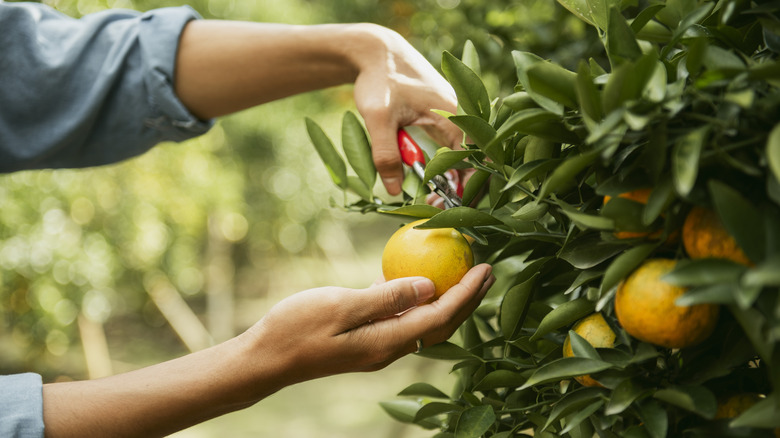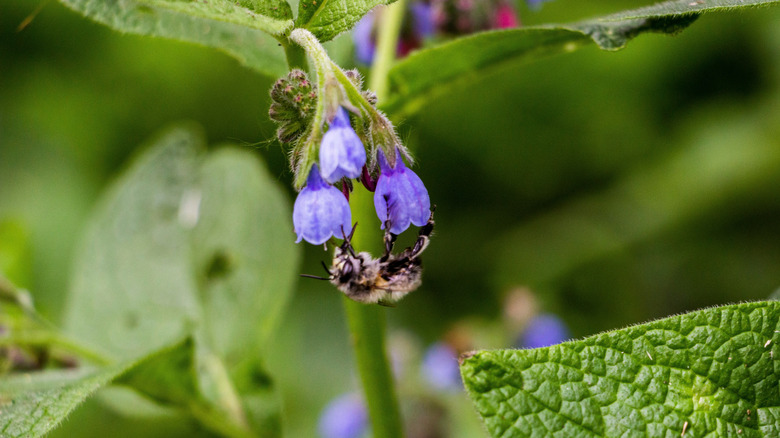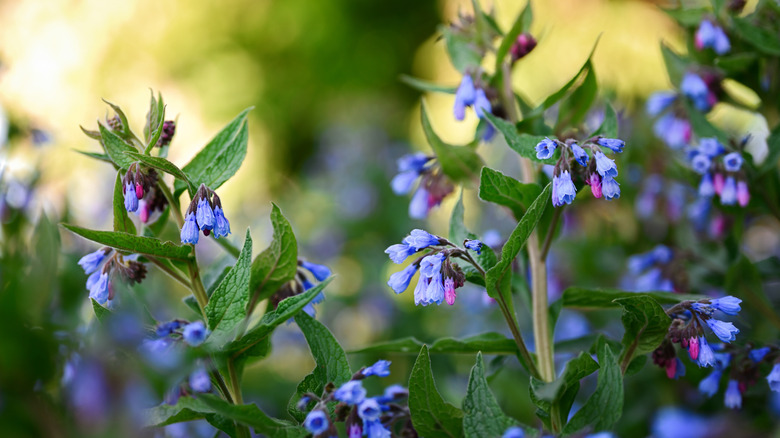The Pollinator-Loving Plant That's The Perfect Companion To Your Fruit Trees
Fruit trees are a joyous addition to any garden. What's better than being able to pick fully ripened, organic produce to snack on right from your very own backyard? Yet, if you have a fruit tree in your garden that's not quite thriving, you may want to reconsider what you plant next to it. Comfrey (Symphytum officinale) is probably not the first plant that comes to mind, but it's one that can do a lot to support the health of your fruit trees, as well as lure in plenty of pollinators for a bumper harvest.
This is because comfrey is a beautiful ground cover that naturally fertilizes fruit trees. Comfrey's roots grow deep, breaking up compacted soil, and pulling up valuable nutrients like nitrogen, phosphorus, potassium, and calcium – nutrients that your fruit trees' shallow growing roots may otherwise miss out on. But it's not just the roots doing all the hard work. Above ground, comfrey's large, leafy growth helps shade the soil, keeping it cool, moist, and relatively weed-free. You can also cut back the leaves and let them decompose in place, a method known as "chop and drop". As these leaves decompose, they will feed nutrients into the soil and act as a natural fertilizer, giving your fruit trees a much-needed boost.
Why pollinators love comfrey
Besides being a plant you should grow in your garden for healthy soil, comfrey is also the perfect way to bring more pollinators into your yard. From bees to butterflies, and even the occasional hummingbird, these pollinators are attracted to comfrey's clusters of bell-shaped flowers that provide a steady source of nectar throughout the spring and summer months. In cooler climates, comfrey can start blooming as early as May and continue through September, offering a reliable food source when few other plants are in flower. That early-season support is especially valuable for local pollinator populations, which often struggle to find nectar in the spring.
Attracting more pollinators to your garden doesn't just benefit these insects, it directly supports the health and productivity of your fruit trees. The more pollinators you have buzzing around, the greater the chances of a healthy fruit tree harvest. Comfrey's tubular flowers are especially appealing to bumblebees, which are among the most effective pollinators for fruit trees like apples, plums, and pears. By planting comfrey nearby, you're not only creating a more vibrant, biodiverse garden, you're also contributing to the long-term health of your fruit trees.
How to plant comfrey to boost the health of your fruit tree
If you're looking for a simple, natural way to support your fruit trees, planting comfrey nearby is an easy way to do so. Hardy in USDA Zones 3 through 9, comfrey grows well in full sun to partial shade and prefers rich, well-drained soil. You can grow it from seed, but if you're looking for quicker and more reliable results, root cuttings are the way to go.
When choosing where to place comfrey in your garden, make sure it's got a bit of breathing room as it can grow up to 2 to 3 feet tall and wide, and its bushy leaves need space to spread. For the best health of your fruit trees, place it in a ring around the drip line (the outermost branches) of the tree. Once planted, comfrey is relatively hands-off, it just needs some regular hydration, especially when it's first starting out. Over time, this perennial plant becomes a low-maintenance companion that helps your fruit trees thrive, but also enriches the soil, and provides steady support for local pollinators season after season.


